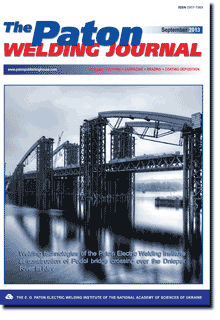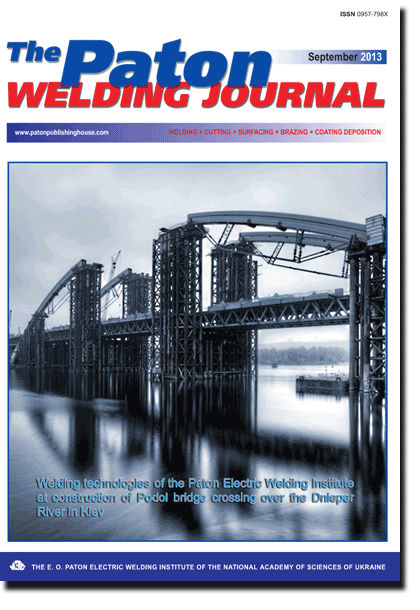| 2013 №09 (03) | 2013 №09 (05) |

The Paton Welding Journal, 2013, #9, 24-29 pages
MODELLING OF PROCESSES OF NUCLEATION AND DEVELOPMENT OF DUCTILE FRACTURE PORES IN WELDED STRUCTURES
E.A. VELIKOIVANENKO, G.F. ROZYNKA, A.S. MILENIN and N.I. PIVTORAK
E.O. Paton Electric Welding Institute, NASU. 11 Bozhenko Str., 03680, Kiev, Ukraine. E-mail: office@paton.kiev.uaAbstract
Evaluation of serviceability and residual life of the critical welded structures with found defect, including pipelines and pressure vessels, assumes a complex analysis of interrelated multidimensional processes, influencing their bearing capacity. At that, grounded reduction of conservatism of such an evaluation is rational that requires description of structure limiting state considering main fracture mechanisms. In particular, ductile fracture is a main mechanism of development of material damage in the main pipelines with typical surface defects of local corrosion wall thinning without accompanying sharp concentrators. Complex methodology for numerical analysis of processes of nucleation and development of ductile fracture pores of metal welded structures as well as criteria for determination of their limiting state was developed in the scope of present work. Thus, a procedure for calculation of stress-strain state in-service structure considering change of load-carrying net-section of structure areas at microporosity growth was build on the basis of Gurson-Tvergaard model. The criteria of pore nucleation as well as mathematical description of different mechanisms of their development depending on character of external force action were proposed for non-isothermal metal state, in particular, in the process of welding heating. Application of the developed approaches was shown on the example of analysis of limiting state of main pipeline element with local wall thinning defect in area of circumferential site weld. It is shown that limiting internal pressure in the pipeline with such service damage is determined by character of interaction of local stresses in zone of the weld and geometrical anomaly, i.e. the lower is the distance between them, the less is the loading necessary for formation of common zone of microdamage in which the macrodefects are formed as a consequence. Similarly, significant effect of pores on the bearing capacity in pipeline site weld is shown. Generality of the developed approaches of numerical analysis of ductile fracture processes allows applying them for evaluation of limiting state and residual life of the welded pressure vessels from high-strength steels. 18 Ref., 1 Table, 3Figures.
Keywords: ductile fracture, pore formation, stress-strain state, limit load, welded joint, main pipeline
Received: 20.06.13
Published: 28.09.13
References
1. Rybin, V.V. (1986) High plastic strains and fracture of metals. Moscow: Metallurgiya.
2. Tvergaard, V. (1990) Material failure by void growth to coalescence. Adv. Appl. Mech., 27, 83-151.
3. Hancock, I., Mackenzie, A.C. (1976) On the mechanism of ductile failure of a high strength steel subjected in multi-axial stress state. J. Mech. and Phys. Solids, 24(213), 147-149.
4. Xue, L. (2008) Constitutive modeling of void shearing effect in ductile fracture of porous materials. Eng. Fract. Mech., 75, 3343-3366.
5.
Nahshon, K., Hutchinson, J.W. (2008) Modification of the Gurson model for shear failure. Eur. J. Mech. Solids A, 27, 1-17.
6. Gurson, A.I. (1977) Continuum theory of ductile rupture by void nucleation and growth. Pt 1: Yield criteria and flow rules for porous ductile media. J. Eng. Mater. and Technol., 1, 2-15.
7. Tvergaard, V., Needleman, A. (1984) Analysis of the cup-cone fracture in a round tensile bar. Acta Metallurgica, 32, 157-169.
8. Needleman, A. (1972) Void growth in an elastic-plastic medium. J. Appl. Mech., 39, 964-970.
9. Karzov, G.P., Margolin, B.Z., Shvetsova, V.A. (1993) Physical-mechanical modeling of fracture processes. St.-Petersburg: Politekhnika.
10. Reznikov, A.N., Shaterin, M.A., Kunin, V.S. et al. (1986) Cutting of metals with plasma heating. Moscow: Mashinostroenie.
11. (1970) Theoretical principles of welding. Ed. by V.V. Frolov. Moscow: Vysshaya Shkola.
12. Sedmak, A., Younise B., Rakinetal, M. et al. Ductile fracture resistance of the weld metal and heat affected zone in a HSLA steel welded joint. http:// www.structuralintegrity.eu/pdf/esis/TC/1/ESIS- TC1-Freiburg-Sedmak%20et%20al.pdf
13. Makhnenko, V.I. (1976) Calculation methods of examination of welding stress and strain kinetics. Kiev: Naukova Dumka.
14. Makhnenko, V.I. (2006) Resource of safety service of welded joints and assemblies of current structures. Kiev: Naukova Dumka.
15. Makhnenko, V.I. (2013) Problems of examination of modern critical welded structures. The Paton Welding J., 5, 21-28.
16. (1967) Physical properties of steels and alloys applied in power engineering: Refer. Book. Ed. by B.E. Nejmark. Moscow; Leningrad: Energiya.
17. (2008) DSTU-N B V2.3-21:2008: Guideline. Determination of residual strength of main pipelines with defects. Kyiv: Minregionbud Ukrainy.
18. Izbenko, V.F., Avramenko, V.I., Krivosheya, V.S. (1974) Experimental investigation of design strength of 14KhGN2MD and VMSt.3 steel joints by hydrostatic buckling method. Avtomatich. Svarka, 3, 26-29.
Suggested Citation
E.A. VELIKOIVANENKO, G.F. ROZYNKA, A.S. MILENIN and N.I. PIVTORAK (2013) MODELLING OF PROCESSES OF NUCLEATION AND DEVELOPMENT OF DUCTILE FRACTURE PORES IN WELDED STRUCTURES. The Paton Welding J., 09, 24-29.The cost of subscription/purchase order journals or individual articles
| Journal/Currency | Annual Set | 1 issue printed |
1 issue |
one article |
| TPWJ/USD | 384 $ | 32 $ | 26 $ | 13 $ |
| TPWJ/EUR | 348 € | 29 € | 24 € | 12 € |
| TPWJ/UAH | 7200 UAH | 600 UAH | 600 UAH | 280 UAH |
| AS/UAH | 1800 UAH | 300 UAH | 300 UAH | 150 UAH |
| AS/USD | 192 $ | 32 $ | 26 $ | 13 $ |
| AS/EUR | 180 € | 30 € | 25 € | 12 € |
| SEM/UAH | 1200 UAH | 300 UAH | 300 UAH | 150 UAH |
| SEM/USD | 128 $ | 32 $ | 26 $ | 13 $ |
| SEM/EUR | 120 € | 30 € | 25 € | 12 € |
| TDNK/UAH | 1200 UAH | 300 UAH | 300 UAH | 150 UAH |
| TDNK/USD | 128 $ | 32 $ | 26 $ | 13 $ |
| TDNK/EUR | 120 € | 30 € | 25 € | 15 € |
AS = «Automatic Welding» - 6 issues per year;
TPWJ = «PATON WELDING JOURNAL» - 12 issues per year;
SEM = «Electrometallurgy Today» - 4 issues per year;
TDNK = «Technical Diagnostics and Non-Destructive Testing» - 4 issues per year.


